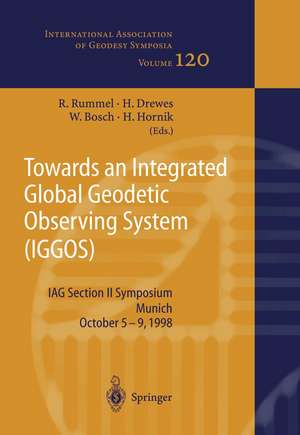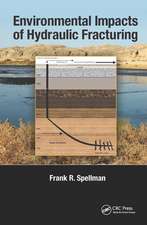Towards an Integrated Global Geodetic Observing System (IGGOS): IAG Section II Symposium Munich, October 5-9, 1998: International Association of Geodesy Symposia, cartea 120
Editat de Reinhard Rummel, Hermann Drewes, Wolfgang Bosch, Helmut Horniken Limba Engleză Paperback – 30 sep 2011
Din seria International Association of Geodesy Symposia
- 15%
 Preț: 660.49 lei
Preț: 660.49 lei - 18%
 Preț: 956.81 lei
Preț: 956.81 lei - 18%
 Preț: 958.38 lei
Preț: 958.38 lei -
 Preț: 440.22 lei
Preț: 440.22 lei -
 Preț: 430.59 lei
Preț: 430.59 lei -
 Preț: 435.38 lei
Preț: 435.38 lei -
 Preț: 405.28 lei
Preț: 405.28 lei - 15%
 Preț: 662.62 lei
Preț: 662.62 lei - 15%
 Preț: 641.38 lei
Preț: 641.38 lei - 15%
 Preț: 642.03 lei
Preț: 642.03 lei - 15%
 Preț: 640.55 lei
Preț: 640.55 lei - 15%
 Preț: 666.89 lei
Preț: 666.89 lei - 18%
 Preț: 975.29 lei
Preț: 975.29 lei - 15%
 Preț: 661.14 lei
Preț: 661.14 lei - 15%
 Preț: 655.45 lei
Preț: 655.45 lei - 15%
 Preț: 644.18 lei
Preț: 644.18 lei - 15%
 Preț: 666.24 lei
Preț: 666.24 lei - 15%
 Preț: 679.00 lei
Preț: 679.00 lei - 15%
 Preț: 662.30 lei
Preț: 662.30 lei - 20%
 Preț: 579.46 lei
Preț: 579.46 lei - 20%
 Preț: 566.39 lei
Preț: 566.39 lei - 24%
 Preț: 1640.04 lei
Preț: 1640.04 lei - 18%
 Preț: 1228.62 lei
Preț: 1228.62 lei - 18%
 Preț: 957.62 lei
Preț: 957.62 lei - 18%
 Preț: 1221.69 lei
Preț: 1221.69 lei - 18%
 Preț: 1234.94 lei
Preț: 1234.94 lei - 24%
 Preț: 1074.62 lei
Preț: 1074.62 lei - 24%
 Preț: 1633.19 lei
Preț: 1633.19 lei - 24%
 Preț: 1199.25 lei
Preț: 1199.25 lei - 24%
 Preț: 1080.15 lei
Preț: 1080.15 lei - 24%
 Preț: 1549.43 lei
Preț: 1549.43 lei - 18%
 Preț: 1232.89 lei
Preț: 1232.89 lei - 18%
 Preț: 1280.86 lei
Preț: 1280.86 lei - 24%
 Preț: 1069.44 lei
Preț: 1069.44 lei - 18%
 Preț: 1238.56 lei
Preț: 1238.56 lei - 24%
 Preț: 1142.96 lei
Preț: 1142.96 lei
Preț: 571.23 lei
Preț vechi: 714.04 lei
-20% Nou
Puncte Express: 857
Preț estimativ în valută:
109.32€ • 118.70$ • 91.83£
109.32€ • 118.70$ • 91.83£
Carte tipărită la comandă
Livrare economică 18-24 aprilie
Preluare comenzi: 021 569.72.76
Specificații
ISBN-13: 9783642641077
ISBN-10: 3642641075
Pagini: 288
Ilustrații: XXII, 261 p.
Dimensiuni: 193 x 270 x 15 mm
Ediția:Softcover reprint of the original 1st ed. 2000
Editura: Springer Berlin, Heidelberg
Colecția Springer
Seria International Association of Geodesy Symposia
Locul publicării:Berlin, Heidelberg, Germany
ISBN-10: 3642641075
Pagini: 288
Ilustrații: XXII, 261 p.
Dimensiuni: 193 x 270 x 15 mm
Ediția:Softcover reprint of the original 1st ed. 2000
Editura: Springer Berlin, Heidelberg
Colecția Springer
Seria International Association of Geodesy Symposia
Locul publicării:Berlin, Heidelberg, Germany
Public țintă
ResearchCuprins
Position Papers.- Importance of a Common Framework for the Realization of Space—Time Reference Systems.- The Use of a Precise Reference Frame in Sea Level Change Studies.- Combination of Space Techniques into one Integrated Processing Model.- Towards an Integrated Global Reference System: Geodesy as a Utility.- Space Techniques and their Coordination within IAG at Present and in Future.- Contributions of VLBI to Space Geodesy.- Towards an Integrated Global Geodetic Observing System.- Envisaging a new era of gravity field research.- Status of the CHAMP Mission.- Satellite Gravity Gradiometry with GOCE.- Integration of geodetic techniques into a global Earth monitoring system and its implication for Earth system sciences.- The Integration of Geodetic Measurements into an Earth Science Observing Program: The Example of Glacial Rebound.- Posters — Session A: Reference System and Datum Integration.- Quality Analysis of some IGS Weekly Combined Solutions with Respect to ITRF.- Geosat and ERS-1 Datum Offsets Relative to Topex/Poseidon Estimated Simultaneously with Geopotential Corrections from Multi—Satellite Crossover Altimetry.- The Integration of Brazilian Geodetic Network into SIRGAS — Preliminary Results.- Construction of the New Japan Datum Using Space Geodetic Technologies.- Deviation of Japanese Vertical Datum and Reference Surface with Respect to the Global Geoid.- Reference Systems Used in Global Navigation Satellite Systems.- Recent Contribution to the ITRF and its Realization in Canada.- Realization and Unification of NAD83 in Canada and the U.S. via the ITRF.- Geodetic Datum Definition of the SAGA Network.- Weak Gravitational Lensing and Instability of the Celestial Reference Frame.- Height Time Series of the Italian GPS Fiducial Network compared with VLBIand SLR Estimations.- Monitoring the Continental Reference Frame in South America.- World Geodetic Datum 2000.- Posters — Session B: Strengths and Weaknesses of Space Techniques.- Validation of TOPEX/POSEIDON Measurements in the Southern Baltic Sea.- DORIS: Contribution of an Orbit Determination System to Accurate and Long Term Altimetry from Space.- IGS Combinations of Polar Motion, Length of Day and Universal Time.- Comparison of Site Velocities Measured by VLBI and GPS in the Key Stone Project Network.- Large Lunar Laser Ranging at its Best.- Combining GPS and CCD to Modernise Astronomical Levelling.- Orbit Modelling Based on Laser and CCD-Observations.- Unification of the GPS Work in Egypt.- Earth Orientation Parameters Measured by Space Geodesy Techniques.- New Method for the Selection of Additional Sites for the Homogenisation of an Inhomogeneous Cospherical Point Distribution.- Westford VLBI to GPS Vertical Tie and Implications for the TRF.- Posters — Session C: Upcoming Gravity Field Satellite Missions.- Impact of terrestrial data on future satellite gravity field solutions.- SAGE: An Italian Project of Satellite Accelerometry.- Accelerometry Aboard CHAMP.- Simulation of the GOCE Gravity Field Mission.- Fundamentals and Applications of the Gravity Field Mission GOCE.- Effects of Inhomogeneous Data Coverage on Spectral Analysis.- Geodetic Applications of the ROCSAT-3/COSMIC Mission.- Estimation of Ocean Mass Redistribution by Means of Altimetry and Circulation Models and its Impact on the Gravity Field.- GFZ and DLR Contribution to a GPS Ground Network to Support the CHAMP Mission.- The ESA Gravity Field and Steady-State Ocean Circulation Explorer Mission: Impact on Solid Earth Physics.- Posters — Session D: Implication for Earth Sciences.- The RegularCharacter of the Plate Motion: Implication for Earth Sciences.- About Global Rotation of the Lithosphere.- Least Squares Collocation Method for Space Geodetic Data Analysis.- BIFROST Project: Studies of Variations of Absolute Sea Level in Conjunction with the Postglacial Rebound of Fennoscandia.- The Indonesian Gravity Field and the Geoid Model.- ISRO Initiatives for Space Geodesy and Geodynamics in India.- A Sketch towards an Integrated Global Geodetic Observing System (IGGOS).- Global Integrated Geodetic and Geodynamic Observing System (GIGGOS).- Authors’ Index.
Textul de pe ultima copertă
The international symposium, "Towards an Integrated Global Geodetic Observing System", held in Munich 5-9 October 1998, analysed the state-of-the-art of geodetic space techniques and looked into the possibility of the establishment of an integrated global observing system. Considering that most geodetic space techniques have reached or approached the one part per billion relative precision level, the question is what their joint and coordinated operation could offer to the study of the Earth system. The symposium was divided into four topics: (1) reference system and datum integration; (2) strength and weakness of space techniques; (3) upcoming gravity field satellite missions; (4) implications for Earth sciences.

















